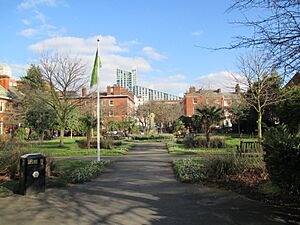St John's Gardens, Manchester facts for kids
St John's Gardens is a lovely park in the middle of Manchester, England. It sits between Lower Byrom Street, Byrom Street, and Quay Street. This peaceful spot used to be home to St John's Church and its graveyard from 1769 to 1931. In 1932, the area was turned into the beautiful garden you see today. There's a special memorial in the center to remember the church and the many people buried there. Most tombstones are covered, but you can still see the grave of John Owens, who started Owen's College. In 2012, the garden won a Green Flag Award, which means it's a great green space. It's also part of the St John Street conservation area.
Contents
A Look Back at St John's Gardens
The original St John's Church was built here in 1769. It was needed because Manchester's population was growing very fast. The church was founded by Edward Byrom, who was born in 1724 and passed away in 1773. He helped start Manchester's first bank. Edward was also the oldest son of John Byrom, whose family was well known in the area.
Over the 1800s, the neighborhood around the church changed a lot. Big family homes became lodging houses, and the area became more about businesses. Fewer people attended the church. Because of this, St John's Church joined with St Matthew's parish in 1927. In 1929, church leaders suggested giving the land to Manchester Corporation. They hoped it would become an open park, like Parsonage Gardens. The church building was taken down in 1931.
Exploring St John's Gardens Today
In March 1914, Manchester Corporation was already talking about turning the old churchyard into a garden. They wanted to change the "eyesore" into a lovely space with trees and plants. Today, a stone cross in the garden remembers the church. A special plaque tells us that more than 22,000 people are buried nearby.
Famous People Buried Here
Two important people buried in the churchyard are John Owens and William Marsden. John Owens started Owens College, which later became Manchester University. William Marsden successfully worked to get workers a half-day holiday on Saturdays. Except for John Owens' grave, all the other tombstones in the churchyard were covered with about 18 inches (46 cm) of soil. The garden and a children's playground officially opened on February 10, 1932.
Special Trees in the Garden
You can find the Black or Manchester Poplar tree in the garden. Its scientific name is Populus nigra (subspecies betulifolia). This tree is Britain's most endangered native tree. Like the London Plane, it's one of the few trees that can grow well even in very polluted places.
In 2011, a small orchard was moved to the garden. It has twelve crab apple trees and wildflowers. This design was created by Daniela Coray. She won a gold award for her design, called A Stitch in Time Saves Nine, at the RHS Tatton Park Flower Show. Coray was also named RHS National Young Designer of the Year.
Green Flag Award
The garden received a Green Flag Award in 2012. This award means the garden is a "welcoming, safe and well-maintained" place for everyone to enjoy. St John's Gardens is also part of the St John Street conservation area.



